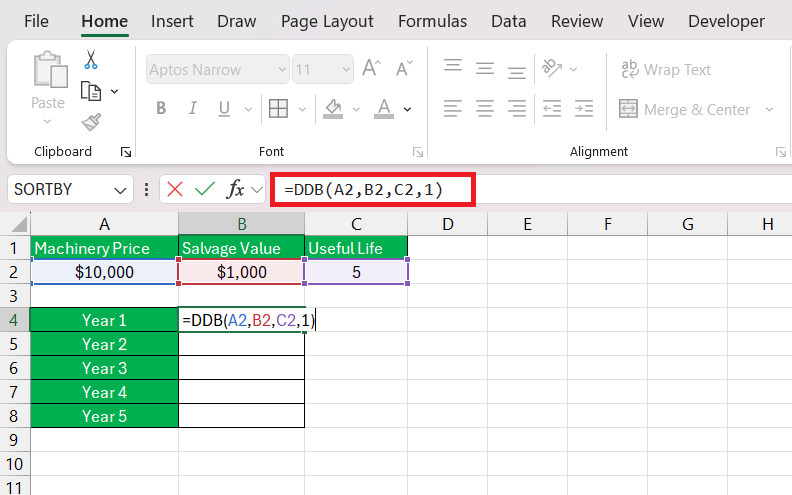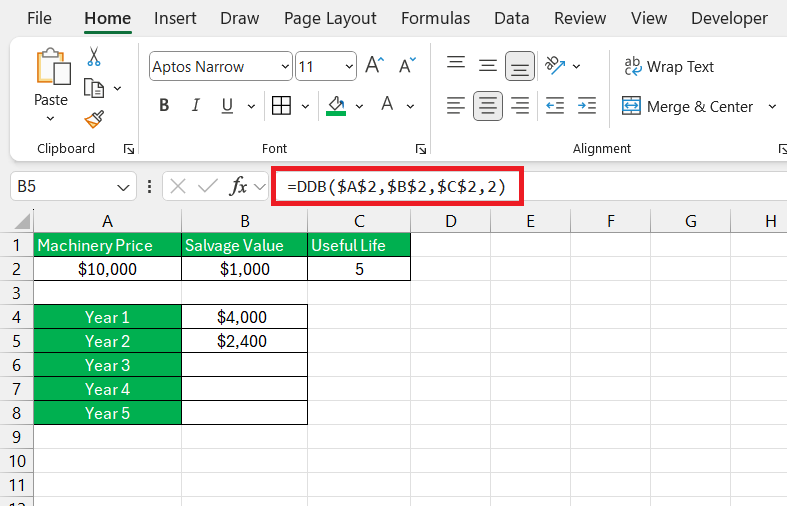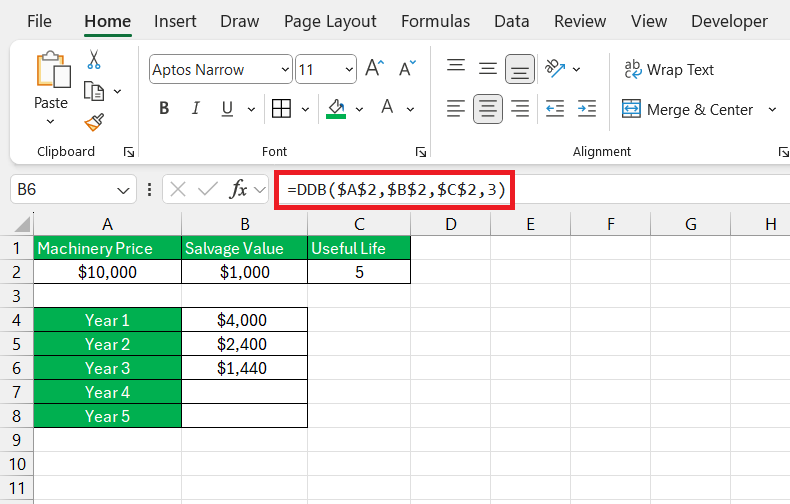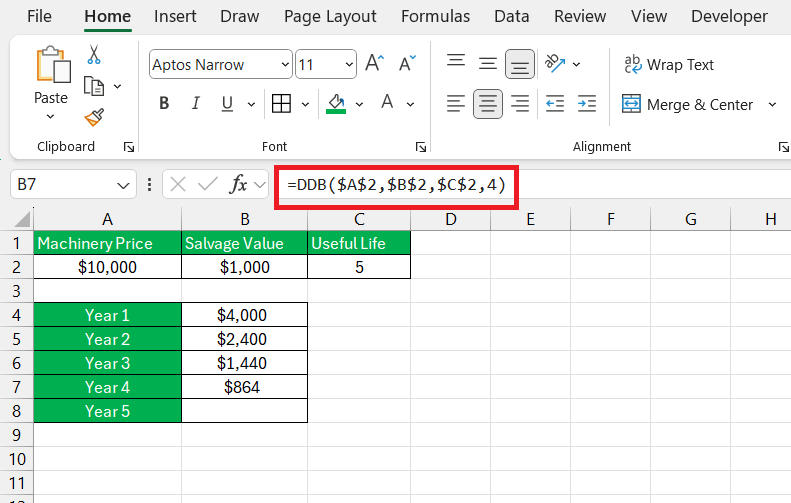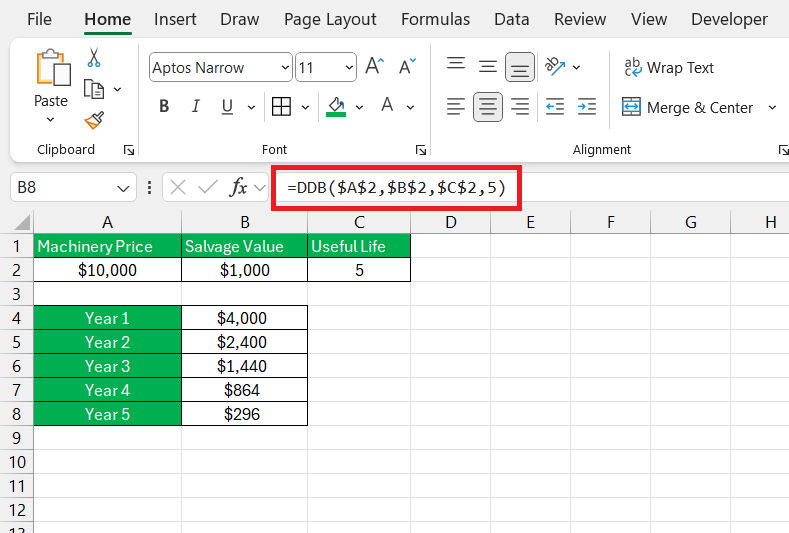Microsoft Excel, the go-to tool for data analysis and financial calculations, offers a plethora of functions designed to make complex tasks simpler. One such function is the DDB (Double Declining Balance) function, which is used to calculate the depreciation of an asset for a specified period using the double declining balance method. This article delves into the details of the Double Declining Depreciation function, its syntax, and practical applications.
Key Takeaways:
- Purpose of Depreciation: Depreciation helps businesses align asset costs with revenue generation over time, smoothing financial impacts and ensuring accurate financial reporting.
- Common Depreciation Methods: Methods like straight-line, declining balance, and double declining balance distribute asset costs differently, catering to various asset types and financial reporting requirements.
- Double Declining Balance Method: This accelerated depreciation method front-loads expenses, reflecting rapid asset depreciation early on, suitable for assets like technology or vehicles.
- Using the DDB Function in Excel: Excel’s DDB function simplifies double declining balance depreciation calculations, requiring inputs such as initial cost, salvage value, asset life, and period for accurate expense tracking.
- Practical Applications: Financial analysts use the DDB method for precise financial statements and tax planning, managing depreciation expenses to optimize taxable income and asset value tracking.
Table of Contents
Understanding the Basics of Depreciation
The Purpose of Depreciation in Accounting
Depreciation in accounting isn’t just about acknowledging that assets lose value over time; it’s about financial savvy. When they spread the cost of an asset across its useful life, companies can match the revenue generated from the asset to its declining value, resulting in a clearer financial picture.
Imagine buying a shiny new piece of equipment: instead of taking a financial hit all at once, depreciation lets you soften the blow year after year. It’s like telling the story of your assets in chapters, rather than revealing the whole plot at once.
An Overview of Common Depreciation Methods
Navigating the world of depreciation methods might feel like picking the right tool for a job. Each method offers its unique spin on how to distribute the cost of an asset throughout its useful life. You’ve got the straight-line method, the dependable classic, reducing value evenly, like slicing a pie into equal parts. Then there’s the declining balance method, more aggressive, chiseling away more value upfront and less over time.
Imagine a snowball rolling downhill, shrinking as it goes – that’s the double-declining balance approach. Units of production offer a pay-as-you-go vibe, matching depreciation to usage. Lastly, the sum of the years’ digits method takes a bit from both worlds, more upfront like declining balance, but with a straight-line twist. Each method shines depending on the asset’s nature and the tale it tells on your financial statement.
The Double Declining Balance Method Unraveled
What Defines the Double Declining Balance Method?
Diving into the double declining balance method is like meeting the sprinter of depreciation techniques. Here, you’re accelerating expenses upfront, quickly diminishing the book value of your assets during the initial years. They calculate depreciation at twice the straight-line percentage rate, rapidly reducing an asset’s book value in the early stages, and then slowing down as the asset ages.
This approach mirrors the reality of many assets that lose their zest faster at the beginning of their life. Vehicles, for example, drive off the lot and immediately lose value faster than they do in later years – the double declining balance method captures this tumble in worth like a snapshot.
How the Double Declining Balance Method Differs from Other Methods
Imagine if depreciation methods were pace runners in a marathon: the double declining balance method would be the one sprinting ahead early in the race. Unlike the even stride of the straight-line method that depreciates the same amount each year, double declining jumps off the start line with larger deductions in the first few years, before slowing down.
It suits those assets that work the hardest in their youth, much like a new car’s steepest value drops as it leaves the dealership. This stands in contrast to methods like the units of production, where depreciation is tied to usage, not time. Recognizing that not all assets age like fine wine, the double declining balance method aims to mirror real-life wear and tear, and front-loading expenses when an asset is fresh and full of potential.
Understanding the DDB Function in Excel
What is the DDB Function?
The DDB function is used to calculate the depreciation of an asset for a specific period based on the double-declining balance method. This method is an accelerated depreciation technique that calculates higher depreciation in the earlier years of an asset’s life and lower depreciation expenses in the subsequent years.
Syntax of the DDB Function
The syntax for the DDB function is as follows:
=DDB(cost, salvage, life, period, [factor])
Where:
- cost (required): This denotes the initial purchase price of the asset.
- salvage (required): This signifies the asset’s value at the conclusion of its useful life.
- life (required): This signifies the entire duration over which the asset will undergo depreciation.
- period (required): This specifies the period for which you intend to compute depreciation. It must be a number between 1 and the asset’s useful life.
- factor (optional): This indicates the rate at which the asset’s value diminishes. If not specified, the default factor is 2, which aligns with the double-declining balance method.
Step-by-Step Guide to Using the DDB Function in Excel
Let’s consider an example to illustrate the use of the DDB function.
You have purchased a piece of machinery for $10,000, and the asset’s residual value at the end of its useful life (5 years) is $1,000. You want to calculate the depreciation for each year using the double-declining balance method.
Year 1: =DDB(10000, 1000, 5, 1)
Year 2: =DDB(10000, 1000, 5, 2)
Year 3: =DDB(10000, 1000, 5, 3)
Year 4: =DDB(10000, 1000, 5, 4)
Year 5: =DDB(10000, 1000, 5, 5)
In each calculation, the depreciation amount decreases, reflecting the accelerated depreciation nature of the double-declining balance method.
Practical Applications
Financial Analysis
Financial analysts often use the DDB function to project the depreciation expense of assets, which helps in creating accurate financial statements and forecasts.
Tax Calculations
Businesses use the DDB method for tax purposes, as it allows for higher depreciation expenses in the initial years, resulting in lower taxable income in those years.
Asset Management
The DDB function aids in tracking the value of assets over time, ensuring that companies can manage their assets effectively and make informed decisions regarding replacements and upgrades.
FAQ: Excel and Double Declining Depreciation
What is the DDB function in Excel?
The DDB function in Excel computes the depreciation of an asset over a specified period using the double-declining balance method, with the option to customize the depreciation rate by adjusting the [factor]. It’s designed for assets that depreciate rapidly during the early stages of their useful life. You’ll need to input the initial cost, salvage value, total lifespan, and the period for which you seek the depreciation expense. It’s a real gem for accelerated depreciation calculations!
How to use the double declining balance in Excel?
To use the double declining balance in Excel, enter the DDB function with the appropriate arguments. Input the asset’s initial cost, salvage value, its estimated useful life, and the period for which you want to calculate depreciation. The function swiftly computes the depreciation expense for that period, reflecting the asset’s rapid value drop in the early stages. It’s a straightforward process that can be repeated for each year of the asset’s life to construct a complete depreciation schedule.
Why is the Double Declining Balance Method Preferred for Certain Assets?
The double declining balance method wins favor for certain assets because it mirrors their real-world wear and tear, with faster value deterioration early on. Think of tech gadgets that seem to age in dog years, or heavy machinery that puts in the hard yards upfront; their book value should drop as quickly as their market value. This method also front-loads depreciation expenses, which can be a clever move for businesses looking to manage taxable income and cash flow in the earlier years of an asset’s life.
Can I Switch from Double Declining to Straight Line Depreciation in Excel?
Absolutely, you can switch from double-declining to straight-line depreciation in Excel, and it’s quite a smooth transition thanks to the VDB function. It starts off like a typical double declining method, but when depreciation slows, it zips smartly into the straight-line approach. This avoids leaving any undepreciated value hanging by the end of the asset’s lifespan. It’s like having an automatic gear in a car that knows the right time to shift for optimal performance.
What Are the Disadvantages of the Double Declining Method?
While the double declining balance method has its perks, it does come with a few drawbacks. Its complexity can cause some furrowed brows compared to the simplicity of the straight-line method. For assets that chug along at a steady pace, this method’s rapid depreciation doesn’t quite match their even usage, potentially misleading the picture of an asset’s efficiency. Also, it tends to skew profit reports, showing lower profits earlier on because of higher depreciation charges, which could be a red flag for potential investors scanning through your financial health.
John Michaloudis is a former accountant and finance analyst at General Electric, a Microsoft MVP since 2020, an Amazon #1 bestselling author of 4 Microsoft Excel books and teacher of Microsoft Excel & Office over at his flagship MyExcelOnline Academy Online Course.

